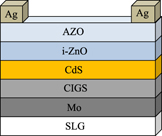No CrossRef data available.
Published online by Cambridge University Press: 09 June 2014

Solution-processed CuInGaS2 (CIGS) thin-film solar cells are promising for large-scale commercialization due to their economic process although the efficiency still needs to be improved to compete with vacuum-based materials. Systematic studies were performed to optimize the series and shunt resistance of hydrazine-based CIGS solar cells. Optimization was achieved through compositional adjustment of copper (Cu) near the p–n junction and gallium (Ga) near the back contact. Cu adjustments optimized the shunt resistance between 4000 and 5000 Ω cm2. Ga adjustments optimized the series resistance to 2 Ω cm2. Shunt and series resistance play vital roles in the fill factor. Fill factor was hence improved upward of 0.80 with the optimization of Cu and Ga. Chemical etching was also conducted to investigate the durability of the materials and to remove small crystals near the interface. Device conversion efficiencies were improved up to 12.4%. This study provides the implications for improving the device performance of chalcogenide solar cell materials.